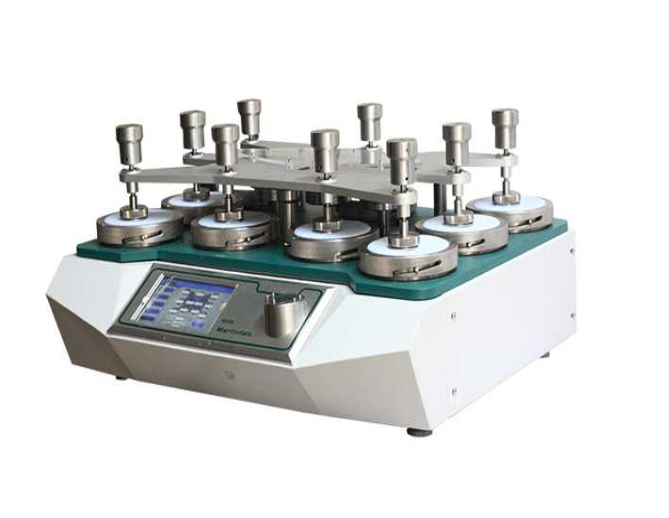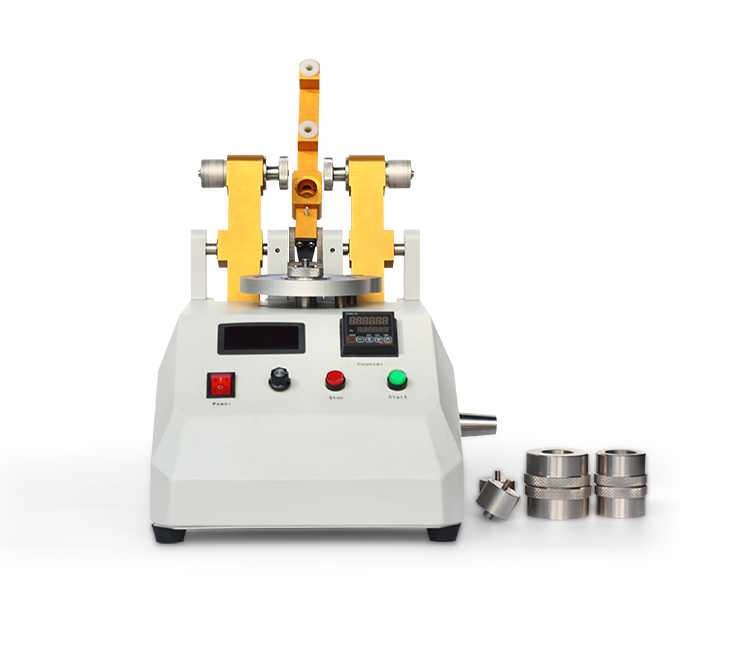What is the difference between Taber and Martindale abrasion tests?
Leather's abrasion resistance refers to its ability to resist wear and tear. Leather abrasion is a major cause of leather damage. Although leather abrasion fastness is not currently regulated by national standards, abrasion resistance testing remains an essential quality measure and is extremely important for evaluating leather's wear resistance.
Depending on the instrument used, two methods are commonly used: the Martindale flat abrasion test and the Taber abrasion test.
Martindale Abrasion Tester
The Martindale Abrasion and Pilling Tester is used to test the abrasion resistance and pilling of materials such as knitted fabrics, wool fabrics, artificial leather, and synthetic leather under pressure. The following is a detailed introduction to the Martindale Abrasion Tester:
Working Principle
The Martindale Abrasion Tester operates by simulating the wear experienced during actual use by subjecting the sample to continuous, quantitative abrasion, thereby evaluating the material's wear resistance. It primarily consists of a parallel-moving test platform and a rotating disc with an abrasion head. The sample to be tested and a standard abrasive material (such as silk or cotton) are secured to a test stand and a rotating disc. As the disc rotates, the abrasion head abrades the sample, simulating the wear experienced in actual use.
Test Methods and Standards
The test methods and standards for the Martindale Abraser typically follow national or international standards, such as GB/T 13775. ASTM D4966. and ISO 12947. The test method typically includes the following steps:
1. Sample Preparation: Prepare a sample of appropriate size according to the test standard or customer requirements, and ensure that the sample surface is flat and free of defects.
2. Test Parameters: Set the Martindale Abraser test parameters, such as friction speed, pressure, and number of passes, according to the test standard or customer requirements.
3. Perform the Wear Test: Secure the sample in the holder and start the instrument, allowing the wear head on the rotating disc to rub the sample. During the test, the wear of the sample can be observed and the test data recorded.
4. Evaluate the Test Results: Evaluate the wear resistance of the sample according to the test standard or customer requirements. Indicators such as the number of passes or the degree of wear are typically used to evaluate the wear resistance of the sample.
Structural Components
The Martindale abrader consists of the following main components:
1. Test stand: Used to secure the sample to be tested and rub it against the abrasion head on the rotating disc.
2. Rotating disc: Attached to the abrasion head, used to perform the abrasion test on the sample.
3. Clamp: Used to secure the sample and prevent it from shifting or deforming during the test.
4. Counter: Records the number of abrasions during the test, ensuring consistency between tests and improving the reliability of the test results.
5. Control system: Used to set test parameters (such as abrasion speed, pressure, and number of abrasions) and monitor the test process.
Applications
The Martindale Abrasion Tester is widely used in various industries, including textiles, leather, and synthetic materials. Through testing, the abrasion resistance of various fabrics can be evaluated, providing important insights for product design and production quality control. The instrument is also suitable for evaluating the abrasion resistance of materials under other conditions, such as water and oil resistance.
Precautions and Maintenance
1. Precautions:
During the test, strictly follow the test standards and operating procedures to avoid human factors that may affect the test results.
Preheat and calibrate the instrument before testing to ensure the accuracy of the test results.
Observe safety precautions during testing to avoid accidents.
2. Maintenance:
Clean and maintain the instrument regularly to ensure proper operation and accurate test results.
Inspect and replace severely worn parts and accessories to extend the instrument's service life.
Record the parameters and results of each test for subsequent data analysis and comparison.
The Taber Abrader, also known as the Taber Abrasion Tester, is a specialized device used to test the wear resistance of materials. The following is a detailed introduction to the Taber Abrader:
Taber Abrader
The Taber Abrader primarily simulates the friction and wear experienced by materials in actual use to assess their wear resistance. This device is widely used for testing the wear resistance of a variety of materials, including fabric, paper, paint, plywood, leather, floor tiles, glass, natural rubber, and artificial flooring, making it an ideal choice for research institutions and factory laboratories.
Working Principle
The Taber Abrader's operating principle is relatively simple yet highly effective. It utilizes two grinding wheels, typically made of a specific wear-resistant material, such as tungsten carbide, which offers high hardness and wear resistance. During testing, a specimen is secured to the instrument's worktable. The grinding wheels are in contact with the specimen surface under a specified pressure and rotate at a specific speed. As the grinding wheels rotate, friction is generated between them and the specimen. After a specified number of rotations or a certain degree of wear, the wear resistance of the material is assessed by measuring parameters such as mass loss, thickness change, and apparent wear.
Structure and Components
The Taber abrader's structure is relatively complex, but its various components work together to perform the wear resistance test. Its main components include:
1. Grinding wheel system: The grinding wheel is a key component of the Taber abrader and is typically made of a wear-resistant material such as tungsten carbide. The number and type of grinding wheels can be selected based on testing requirements to accommodate different materials and coatings.
2. Workbench: The workbench secures the specimen, ensuring stability and accuracy during testing. The workbench design typically takes into account the specimen's size and shape, allowing for easy installation and removal.
3. Control system: The control system is the core component of the Taber abrader, responsible for controlling various test parameters such as speed, load, and test time. It also features data logging and display capabilities, enabling real-time monitoring and analysis of test results.
4. Counter: The counter records the number of grinding wheel revolutions to ensure accuracy and repeatability. The counter typically uses an LCD display and supports an automatic stop function, terminating the test after reaching the specified number of revolutions.
5. Load Cell: The load cell is used to apply a certain amount of pressure between the grinding wheel and the specimen to simulate the friction and wear conditions experienced in actual use. The quality and precision of the load cell significantly impact the accuracy of the test results.
Test Parameters and Standards
The Taber Abraser can test the surface wear resistance of various materials and coatings under various test conditions, such as load, rotational speed, and friction head. Furthermore, the Taber Abraser complies with numerous domestic and international standards, including QB/T2726-2005. ASTM D4060. ASTM D1175. D1044. DIN 53754. 53799. 53109. 52347. ISO 5470. GB/T 4085. GB 5478. TAPPI-T 476. and GB/T 17657-2013.
Applications
The Taber Abraser has a wide range of applications, covering a wide range of industries and fields. Its main application areas include:
1. Coatings Industry: Used to test the abrasion resistance of coatings to assess their durability and service life in actual use.
2. Plastics Industry: Used to test the abrasion resistance of plastic products to assess their service life in environments such as mechanical friction and chemical corrosion.
3. Rubber Industry: Used to test the abrasion resistance of rubber products to assess their service life and performance in environments such as friction and compression.
4. Paper Industry: Used to test the abrasion resistance of paper to assess its durability and quality in processes such as printing and writing.
5. Textile Industry: Used to test the abrasion resistance of textiles to assess their durability and quality in processes such as wearing and washing.
6. Flooring Industry: Used to test the abrasion resistance of flooring materials to assess their service life and performance in environments such as trampling and friction.
In addition, Taber abrasion testers are widely used in the automotive, electronics, and construction industries, providing strong support for material quality control and performance evaluation.
Maintenance
Maintenance of the Taber Abraser is crucial for its long-term stable operation and accurate test results. Therefore, users should regularly clean and maintain the instrument. This includes removing debris and stains from the grinding wheel, worktable, and fixtures, and inspecting and replacing any severely worn grinding wheels and accessories.
Taber Wear vs. Martindale Wear Comparison Table
| Comparison Items | Taber Wear Method | Martindale Wear Method |
|---|---|---|
| Core Principle | Two grinding wheels rub against a rotating sample surface under constant pressure, forming a Lissajous pattern. | The sample undergoes a complex, multi-directional (Lissajous pattern) relative motion against a standard rubbing cloth under constant pressure. |
| Motion Method | The sample rotates, and the grinding wheels perform a fixed circular motion on the sample. | The rubbing head (with the rubbing cloth) rotates, and the sample undergoes a complex, multi-directional motion on a flat surface. |
| Contact Type | Two-point contact (two grinding wheels) | Surface contact (circular sample and standard rubbing cloth) |
| Applied Pressure | Pressure is applied directly to the grinding wheels via a load cell (usually in grams or Newtons). | Pressure is applied to the test sample via a weight (usually in kilopascals or grams). |
| Key Evaluation Parameters | Mass loss, thickness change, and appearance change (e.g., show-through, color change). | Number of wear cycles (e.g., holes, severe discoloration), pilling level. |
| Main Application Materials | Hard or sheet materials such as fabric, paper, paint, plywood, leather, floor tiles, glass, plastic, and rubber. | Soft textiles and thin materials such as knitted fabrics, woolen fabrics, artificial leather, and synthetic leather. |
| Examples of Test Standards | QB/T 2726-2005. ASTM D4060. ASTM D1044. ISO 5470 | GB/T 13775. ASTM D4966. ISO 12947 |
| Main Test Purpose | Evaluate the abrasion resistance, scratch resistance, and service life of a material surface. | Evaluate the abrasion resistance and pilling resistance of a material (especially for textiles). |
2025-10-17 14:00


